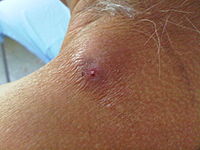
Photo from wikipedia
Myasis is the infestation by fly larvae (Diptera) in live vertebrates including humans. Myasis has been reported most commonly in tropical and subtropical areas around the world with poor sanitation… Click to show full abstract
Myasis is the infestation by fly larvae (Diptera) in live vertebrates including humans. Myasis has been reported most commonly in tropical and subtropical areas around the world with poor sanitation and presence of cattle. Neonatal umbilical myiasis is an important cause of death in bovines and produces major economic losses in the livestock industry. However, its presentation in humans is rare, with a few cases reported worldwide. Moreover, umbilical myasis can be life-treating due to the risk of larvae migration to deeper tissues of the abdomen, omphalitis, and sepsis. We describe the case of a 7-day-old infant admitted to the hospital due to umbilical cord myiasis. In total, 55 larvae were removed from the wound and identified as Cochliomyia hominivorax. The patient recovered satisfactorily after treatment with ivermectin and amoxicillin. A literature search was performed in Pubmed, Medline, Lilacs and Google Scholar, with 64 cases of myasis by C. hominivorax being reviewed. Oral cavity, wounds, scalp and natural orifices are the main affected anatomical areas. Risk factors include the extremes of age, male sex, poor hygiene, alcohol and drug use, cancer, and mental disability. Programs for human myiasis prevention and surveillance are needed in neotropical areas where living conditions make it difficult to implement control strategies.
Journal Title: Frontiers in Medicine
Year Published: 2019
Link to full text (if available)
Share on Social Media: Sign Up to like & get
recommendations!